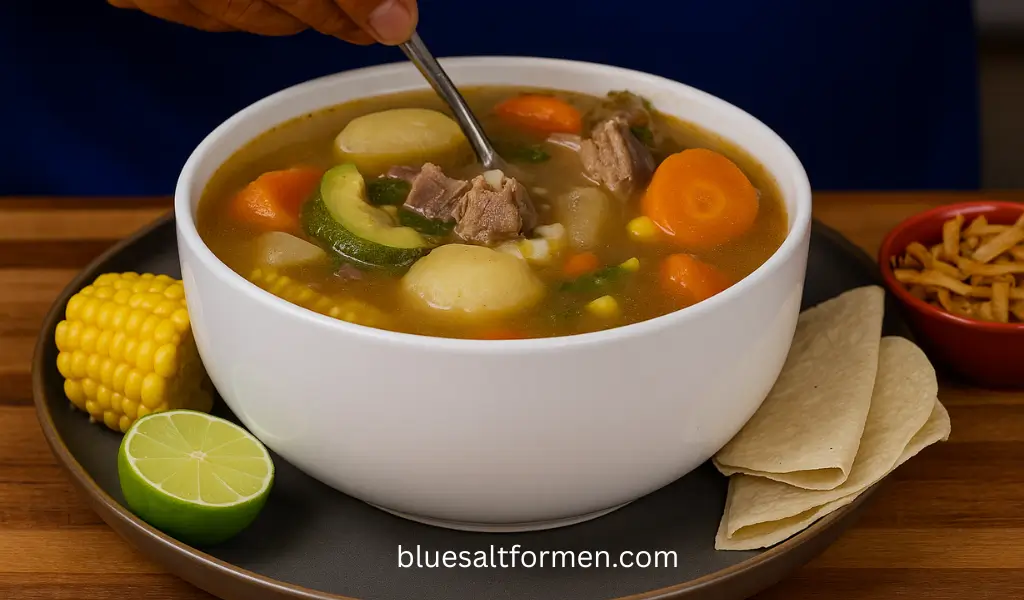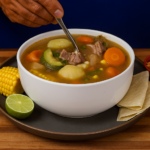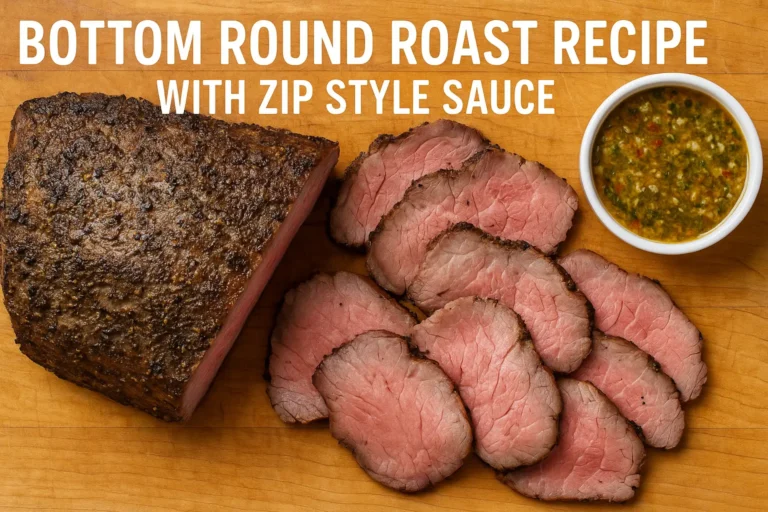Caldo De Res Recipe (Mexican Beef Soup)

Caldo de Res is a traditional Mexican beef soup known for its comforting taste, nutritional value, and deep cultural roots. It’s often made with bone-in beef shanks, vegetables like corn and carrots, and seasoned with herbs to create a flavorful broth.
Why does this soup matter so much in Mexican households? Because it represents far more than a meal. It’s a reminder of home, heritage, and shared moments around the table. People of all ages cherish it not just for taste, but for the comfort it brings, especially when someone is sick or recovering.
What Is Caldo De Res?
Caldo de Res is a hearty Mexican soup made with beef and vegetables, simmered for hours to create a rich and comforting broth. The term literally means “beef broth” in Spanish. Unlike lighter soups, Caldo de Res is packed with whole chunks of meat and large pieces of vegetables, making it a full, satisfying meal.
Common vegetables include corn on the cob, potatoes, carrots, chayote, cabbage, and green beans. It’s often served with a side of rice, lime wedges, and warm corn tortillas.
This soup is especially popular during cooler months but is enjoyed year-round. Its strength lies in the slow-cooking process, which extracts deep flavors from the bones and beef. As a result, the broth is rich in nutrients, collagen, and taste.
Over time, it has become a symbol of family, comfort, and tradition in many Mexican homes and communities.
What Makes Caldo de Res Special?
The uniqueness of Caldo de Res comes from its combination of tender beef, vibrant vegetables, and flavorful broth. Unlike other soups, this dish uses large cuts of beef, typically including beef shank or short ribs, which add a hearty, meaty flavor to the soup.

The beef is simmered for hours, allowing all the natural flavors to infuse the broth. What sets Caldo de Res apart is its simplicity and ability to showcase the freshness of each ingredient.
Caldo de Res (Mexican Beef Soup)
Equipment
- Large stockpot or Dutch oven
- Skimmer or spoon for removing impurities
- Knife and cutting board
- Measuring spoons
- Ladle
Ingredients
- 4 beef shank steaks
- Soup bones (beef marrow bones)
- 2 carrots, peeled and chopped
- 2 zucchinis, chopped
- 2 calabazas (Mexican squash), chopped
- 2 whole corn cobs, cut into quarters
- 2 celery stalks, chopped
- ⅓ head of cabbage, chopped
- 2 Roma tomatoes, chopped
- 2 russet potatoes, peeled and chopped
- ¼ cup tomato sauce (optional)
- 3 garlic cloves, peeled
- 1 medium onion, halved
- 2 tablespoons APC OG (all-purpose seasoning: salt, pepper, garlic)
- 2 teaspoons cumin (comino)
- Water (enough to cover ingredients and adjust as needed)
Instructions
- Prepare the base: Rinse soup bones thoroughly and place them in a large stockpot. Cover with water (but not too much—you can add more later) and bring to a simmer over medium heat.
- Skim impurities: As the bones simmer for 20–30 minutes, skim off any froth or impurities that rise to the top.
- Add beef shanks: Add the beef shank steaks to the pot. Continue simmering for about an hour to extract flavor and ensure the meat becomes tender.
- Add aromatics and base vegetables: Add the halved onion, garlic cloves, celery, corn pieces, and optional tomato sauce. Simmer for 15 minutes.
- Add carrots: Once the broth begins to develop deeper color and flavor, stir in the chopped carrots. Simmer for another 10 minutes.
- Add cabbage and tomatoes: Add chopped cabbage and Roma tomatoes, allowing them to soften and meld into the broth.
- Add potatoes: Add potatoes and cook until fork-tender and the meat is falling apart (about another 30–45 minutes).
- Season to taste: Season with APC OG seasoning and cumin. Adjust seasoning and water level as needed.
- Serve: Serve hot with a side of Spanish rice, lime wedges, and hot sauce. Optional: scoop out and enjoy the bone marrow for a rich, authentic touch.
Notes
- Timing tip: Don’t rush the process—the longer, slower cook ensures maximum flavor and tenderness.
- Water tip: Start with less water and add more as needed during cooking.
- Customization: Feel free to experiment with other vegetables like chayote, green beans, or even chiles for heat.
- Serving tip: Some like to serve the broth and vegetables in one bowl and the beef separately—both ways are delicious.
- Tradition tip: Adding Spanish rice directly into the soup is a personal and family-favorite twist.
The Importance of Broth in Caldo de Res
The key to a great Caldo de Res is its broth. Simmering the beef for hours creates a deep, savory broth that is the foundation of the soup. This rich broth is filled with flavor, and as it cooks, the fat from the beef melds with the other ingredients, creating a perfect balance. When made correctly, the broth should be both flavorful and aromatic, making it one of the standout features of the dish.
If you’re looking for another comforting dinner idea, don’t miss this
Health Benefits of Caldo De Res
Caldo de Res is a nutrient-dense soup that supports immunity, digestion, and overall well-being. It’s rich in protein, vitamins, and minerals thanks to its beef bones and variety of vegetables.
Here are a few key health benefits:
- Bone broth from beef shanks contains collagen, calcium, and magnesium, which promote joint health.
- Vegetables like carrots, potatoes, and cabbage offer fiber, antioxidants, and essential vitamins like A, C, and K.
- Slow cooking retains nutrients better than frying or high-heat methods, making this soup easier to digest and more beneficial overall.
- Hydration improves due to the broth content, helping when sick or during cold weather.
Because it’s balanced in protein, carbs, and fats, it also works as a complete meal. Adding lime juice and fresh cilantro at the end boosts flavor and adds a dose of vitamin C.
Why You Should Try Caldo de Res
Caldo de Res is not only delicious but also highly nutritious. It’s a well-balanced meal that provides protein from the beef and vitamins from the vegetables. The rich, hearty broth is comforting and soothing, making it the perfect dish for a family meal or when you need to nourish your body.
The dish also brings people together, often served in large pots for family and friends to enjoy, making it an essential part of Mexican culture.
How to Serve Caldo De Res
Serve Caldo de Res hot in deep bowls with sides like rice, lime wedges, fresh cilantro, and warm corn tortillas. These accompaniments help enhance the soup’s flavor and texture.
Traditional serving tips include:
- Add fresh lime juice just before eating to brighten the broth.
- Include chopped cilantro and onion for extra freshness and aroma.
- Serve with jalapeños or hot sauce on the side for a spicy kick.
- Pair with Mexican rice or white rice to soak up the flavorful broth.
It’s common to serve the meat and vegetables in one bowl and the broth in another. Some people shred the beef to make it easier to eat with tortillas, almost like a taco.
No matter how you serve it, the key is keeping the soup hot and fresh to maintain its comforting quality.

Conclusion:
Caldo de Res continues to be one of the most beloved soups in Mexican cuisine due to its taste, health value, and emotional connection to family life. It’s not just a recipe, It is a tradition passed down through generations, often made with care, patience, and love.
Its powerful broth, tender beef, and hearty vegetables make it both nourishing and satisfying. Whether you’re making it to recover from a cold, feed a large family, or just enjoy a quiet bowl by yourself, Caldo de Res delivers warmth in every bite. Serve it with love, and it will always taste better.
For those who enjoy restaurant-style comfort food at home, try this Starbucks Medicine Ball Recipe, which is a soothing tea blend perfect after a hearty soup like Caldo De Res.







